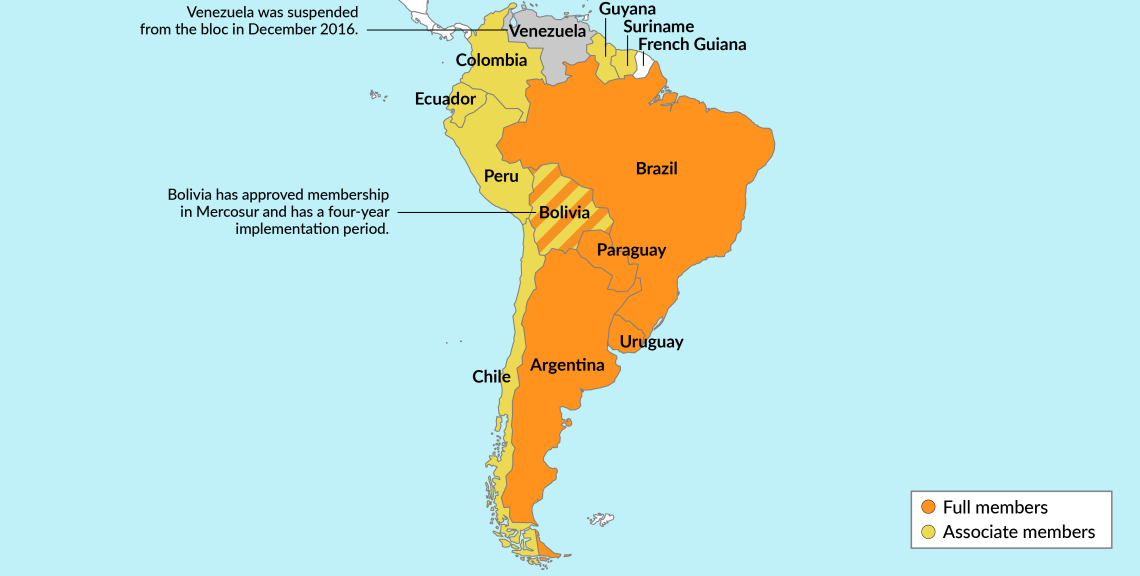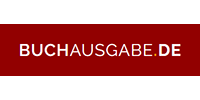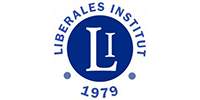Implications of an EU-Mercosur trade deal
Negotiations for a free trade agreement (FTA) between the European Union and the Southern Common Market – known by the Spanish abbreviation Mercosur (Mercado Comun del Sur), the Portuguese Mercosul (Mercado Comum do Sul), or Nemby Nemuha in Guarani – have been ongoing since 1999. Implementation of a draft deal signed in 2019 remains stalled and its future has become increasingly uncertain following the election of Argentina’s President Javier Milei and amid opposition from some corners of Europe. Nonetheless, Brazil’s President Luis Inacio “Lula” da Silva and European Commission President Ursula von der Leyen have both indicated renewed efforts to finalize a deal. Something may even emerge in the coming days at the G20 summit in Brazil.
Mercosur/Mercosul
Argentina, Brazil, Paraguay and Uruguay established Mercosur in 1991 through the Treaty of Asuncion with the goal of promoting free trade and fluid movement of goods, people and capital among its member states. The initiative followed the re-democratization processes in South America and was seen as a way to strengthen economic and political ties in the region. In 2024, Bolivia’s senate voted to approve the protocol for the country to become a member (Venezuela is also a full member, but it has been suspended since December 2016).
Throughout the 1990s and early 2000s, Mercosur made significant progress in reducing tariffs and promoting economic integration among its members. Nonetheless, other attempts at regional integration, such as a common currency, have stalled or fallen short, and member states have often had conflicting visions of the bloc’s role. Moreover, although Mercosur has signed various trade agreements with countries such as Egypt, India and Israel, it has yet to strike a deal with the world’s biggest economies: the United States, China and the EU.
A host of issues have contributed to Mercosur’s struggle to fully realize its potential as a regional economic integration project. These include economic asymmetries among member states, as Brazil and Argentina account for nearly 95 percent of the bloc’s gross domestic product (GDP) and 92 percent of its population. Additionally, protectionist tendencies that contradict the bloc’s free trade principles and limit internal market integration often prevail, as do political instability and economic crises among member states.
Hopes to integrate the region are also hampered by low intra-bloc trade, complex and sometimes conflicting regulations between members, weak enforcement of the bloc’s decisions and agreements, poor transportation links between member countries and limited progress on services and investment. Politicization and ideological changes in member states’ leaders have also affected the organization’s cohesion and effectiveness.
The state of Mercosur-EU negotiations
Talks for a trade agreement between Mercosur and the EU began in 1999, marking one of the longest-running negotiations in recent history. The goal was to create a comprehensive free-trade agreement that would cover not only goods and services but also investment, government procurement and intellectual property rights. Both sides saw potential benefits: for Mercosur, increased access to the EU’s large consumer market and advanced technology, and for the EU, expanded opportunities in South America’s growing economies. In the Mercosur countries, an agreement would provide tangible economic benefits and encourage further economic and political integration, strengthening Latin America’s position in global affairs.
The goal was to create a comprehensive free trade agreement to cover not only goods and services but also investment, government procurement and intellectual property rights.
Nonetheless, talks floundered due to opposition from European farmers who feared being undercut on price by imports from Latin America, EU environmental concerns and worries over human rights and labor issues, as well as protectionist politicians in both EU and Mercosur countries. In South America, there are concerns over the deal’s impact on local industries and trouble getting buy-in from free trade skeptics like Argentina’s President Milei.
In particular, the election of leftist leaders – Brazil’s President Lula (2002-2010) and Dilma Rousseff (2010-2016); Argentina’s Nestor Kirchner (2003-2007), Cristina Fernandez (2007-2015) and Alberto Fernandez (2019-2023); and Uruguay’s Tabare Vazquez (2005-2010, 2015-2020) and Jose Mujica (2010-2015) – resulted in attempts at “South-South cooperation” through organizations like BRICS and UNASUR rather than the pursuit of stronger ties with Europe.
Facts & figures
Countries of the Mercosur bloc


The Mercosur trading bloc is growing to include Bolivia, while Venezuela’s membership has been suspended. Associated member states are those in the Latin American Integration Association (ALADI) with whom Mercosur has free trade agreements.
Forced to look elsewhere to pursue free trade agreements, the EU signed fully fledged agreements with two Latin American groups (Cariforum and the Central America Association), a multiparty trade agreement with three members of the Andean Community (Colombia, Ecuador and Peru), and bilateral agreements with Chile and Mexico. During that time, immense growth in Chinese trade and investment in Latin America helped China easily supplant the EU as the region’s second-largest trade partner and Mercosur’s largest trade partner.
That gap may narrow. If ratified, the EU-Mercosur deal would cover a market of over 750 million consumers – nearly 10 percent of the world’s population – and nearly 20 percent of the world’s GDP. In terms of population, it would also represent the largest trade deal struck by both the EU and Mercosur. Concretely, it would eliminate tariffs on more than 90 percent of Mercosur’s exports to the EU, allowing increased access to the European market for Mercosur’s agricultural goods such as beef, poultry, sugar and ethanol, while benefitting EU manufacturers looking to grow their exports by slashing duties on cars, car parts, chemicals, machinery and textiles. Indeed, according to the European Commission, the FTA would save 4.5 billion euros in duties annually.
Challenges to a European-South American deal
EU member states, particularly France, Ireland and Austria, and potentially Poland, have expressed concerns about the deal’s potential impact on both European agriculture and the Amazon rainforest. Under the proposed agreement, for example, the EU would open its markets to a quota of up to 99,000 tons of beef per year from Mercosur countries, threatening European beef producers. Farmers across the EU have voiced opposition to the agreement through the enormous COPA-COGECA union because they fear being undercut on price. Human rights and labor standards issues have also played roles in recent years, including a letter from civil society organizations calling on the EU to halt the trade negotiations to improve the human rights situation in Brazil under ex-president Jair Bolsonaro (2019-2022).
Environmental organizations have criticized the agreement, arguing it could lead to increased deforestation. They are now backed by European law. In 2023, the EU approved a Deforestation Regulation (EUDR) which applies to imports of seven commodities (cattle, cocoa, coffee, palm-oil, rubber, soya and wood). These products are not authorized for import or sale into the EU unless they meet three criteria, including being deforestation-free. Cognizant of how this could stall things, Brazilian diplomats have been working on overcoming differences on these safeguards.
Changes in leadership in both Europe and South America have affected the negotiations, with some leaders more supportive of the deal than others. Upon assuming Mercosur’s six-month rotating presidency in July 2023, Brazil’s President Lula had declared that closing the free trade agreement was a priority. He was, however, unable to realize this objective as some EU member states maintained their resistance to the FTA.
Read more by U.S. Naval Academy Associate Professor Dr. John Polga-Hecimovich
- Venezuela: Maduro’s totalitarian turn
- Central America’s dysfunction grinds on
- What does the rise of Javier Milei mean for Argentina?
Conversely, prior to assuming the pro tempore presidency in December 2023, Paraguay’s President Santiago Pena affirmed that the bloc would give up on the EU negotiations and instead pursue trade with other partners. Then, in February 2024, Paraguay’s Foreign Minister Ruben Ramirez stated that Paraguay and Argentina’s governments agreed that negotiations for a free trade deal between Mercosur and the EU would not advance any further.
On the campaign trail, Mr. Milei even suggested withdrawing Argentina from Mercosur, although this threat has yet to materialize. Nonetheless, President Milei did not attend the Mercosur Summit in Paraguay on July 8, 2024, citing “scheduling conflicts.” Despite Mr. Pena and Mr. Milei’s tepid support, Lula and the Brazilian contingent appear confident that a deal is close.
Ultimately, both sides are still working to overcome the remaining obstacles, with discussions continuing on how to address environmental concerns and other contentious issues.
Scenarios
Most Likely: The EU-Mercosur agreement is ratified
Brazil’s President Lula and European Commission President von der Leyen met at the United Nations in September 2024 and indicated that they had ironed out some of the differences in negotiations between the two blocs. Taking them at their word, ratification seems to be the most likely outcome.
The deal could be partially adopted by a qualified majority of at least 15 EU countries – after which it would require ratification by the European Parliament – meaning that a lack of support from say, France and Austria, would not pose an existential threat. Meanwhile, Paraguay’s President Pena and even Argentina’s President Milei could be convinced to sign on given the trade possibilities that the FTA would open. If ratification were to happen, it would likely occur during the G20 meeting in Brazil in November 2024.
An EU-Mercosur trade agreement would have significant implications for global geopolitics. It would boost trade flows, economic integration and political ties between Europe and South America, potentially leading to increased cooperation on other global issues. Modifications in the agreement over potential environmental effects, particularly regarding Amazon deforestation, could influence global climate politics.
A free trade agreement between the two blocs would also affect global great power competition. Notably, the agreement could serve as a counterbalance to the economic influence of China in both Europe and the Southern Cone. The deal would increase EU exports to South America, potentially displacing some Chinese goods while permitting European companies to gain advantages over Chinese firms in sectors like manufacturing, technology and services. This, in turn, might undermine China’s ability to leverage economic ties for political influence in the region. Furthermore, there is a chance that the agreement could compete with China’s Belt and Road Initiative projects in South America, offering Mercosur countries an alternative source of investment and economic partnership.
Beyond this, the agreement would likely promote EU standards in areas like labor rights, environmental protection and intellectual property, which would present a challenge to China’s preferred approaches in these areas. And because increased trade and trade dependence between states tend to produce geopolitical bonds and even foreign policy convergence, closer EU-Mercosur ties could shift Mercosur member states’ diplomatic stances on global issues away from China and toward EU (and U.S.) positions.
Possible: The EU-Mercosur deal remains in limbo
Of course, given the two-decade period of negotiations and then five years of stalled ratification, the status quo may also prevail. It is also possible that the presidents of Mercosur member states fail to reach an internal decision about the deal, kicking the can down the road for a time when there could be greater ideological cohesion in the group. If anything has defined Mercosur to date, it is the lack of a single coherent vision. Conversely, EU negotiators may not be convinced the Mercosur members, and specifically Brazil, can currently meet the environmental standards that the EU demands.
This may not prove to be a death knell for Mercosur, as some have argued, but it would certainly accelerate Mercosur member states’ pivot toward China and toward the single-country bilateral trade agreements that Uruguay, Paraguay and others have recently pursued. It would also weaken Europe’s presence and influence in Latin America while barring the EU from many of the inexpensive commodities that Latin America could offer.
Less likely: The EU-Mercosur deal dies
A dead deal is also a possibility, albeit a smaller one. The free trade agreement has the support of most EU leaders as well as the leftist President Lula in Brazil, and success – or the status quo – seem much more likely than those leaders allowing a disaffected party like those led by Presidents Milei and Pena to scuttle the deal. If this were to happen, however, it would echo many of the tendencies of the prior scenario, but with more severe outcomes.
As before, this would also push Mercosur member states toward China, Indo-Pacific countries and others. However, in more existential terms, a dead deal could also mark the end of the usefulness of Mercosur itself, with member states abandoning cohesion and group negotiations in favor of purely bilateral deals.
Geopolitically, this would reflect the EU’s weak influence on Latin America and the region’s relative lack of importance compared to North Africa, North America or the Indo-Pacific. On a slightly less negative note, this would probably not hamper overall economic growth in Latin America or Europe, given modest growth projections of 0.02 percent for the EU and 0.12-0.16 percent for Mercosur countries from the implementation of the agreement.
This report was originally published here: https://www.gisreportsonline.com/r/implications-eu-mercosur-deal/





























